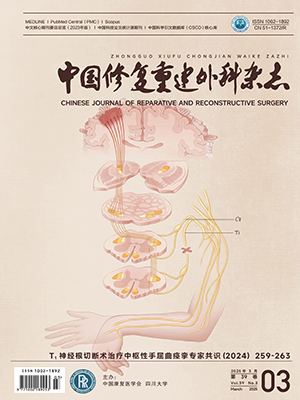| 1. |
Lantry JM,Roberts CS,Giannoudis PV.Operative treatment of scapular fractures:a systematic review.Injury,2008,39(3):271-283.
|
| 2. |
Cole PA,Dubin JR,Freeman G.Operative techniques in the management of scapular fractures.Orthop Clin North Am,2013,44(3):331-343,viii.
|
| 3. |
Pizanis A,Tosounidis G,Braun C,et al.The posterior two-portal approach for reconstruction of scapula fractures:results of 39 patients.Injury,2013,44(11):1630-1635.
|
| 4. |
Jones CB,Cornelius JP,Sietsema DL,et al.Modified Judet approach and minifragment fixation of scapular body and glenoid neck fractures.J OrthoP Trauma,2009,23(8):558-564.
|
| 5. |
Obremskey WT,Lyman JR.A modified judet approach to the scapula.J OrthoP Trauma,2004,18(10):696-699.
|
| 6. |
Ideberg R,Grevsten S,Larsson S.Epidemiology of scapular fractures.Incidence and classification of 338 fractures.Acta OrthoP Scand,1995,66(5):395-397.
|
| 7. |
Ban I,Troelsen A,Christiansen DH,et al.Standardised test protocol (Constant Score) for evaluation of functionality in patients with shoulder disorders.Dan Med J,2013,60(4):A4608.
|
| 8. |
Angst F,Schwyzer HK,Aeschlimann A,et al.Measures of adult shoulder function:Disabilities of the Arm,Shoulder,and Hand Questionnaire (DASH) and its short version (QuickDASH),Shoulder Pain and Disability Index (SPADI),American Shoulder and Elbow Surgeons (ASES) Society standardized shoulder assessment form,Constant (Murley) Score (CS),Simple Shoulder Test (SST),Oxford Shoulder Score (OSS),Shoulder Disability Questionnaire (SDQ),and Western Ontario Shoulder Instability Index (WOSI).Arthritis Care Res (Hoboken),2011,63 Suppl 11:S174-188.
|
| 9. |
Hawker GA,Mian S,Kendzerska T,et al.Measures of adult pain:Visual Analog Scale for Pain (VAS Pain),Numeric Rating Scale for Pain (NRS Pain),McGill Pain Questionnaire (MPQ),Short-Form McGill Pain Questionnaire (SF-MPQ),Chronic Pain Grade Scale (CPGS),Short Form-36 Bodily Pain Scale (SF-36 BPS),and Measure of Intermittent and Constant Osteoarthritis Pain (ICOAP).Arthritis Care Res (Hoboken),2011,63 Suppl 11:S240-252.
|
| 10. |
王勇,许兵,吴银生,等.直切口与 Judet入路治疗肩胛骨颈部及体部骨折的对比研究.中华骨科杂志,2013,33(10):1018-1023.
|
| 11. |
Schandelmaier P,Blauth M,Schneider C,et al.Fractures of the glenoid treated by operation.A 5to 23-year follow-uP of 22 cases.J Bone Joint Surg (Br),2002,84(2):173-177.
|
| 12. |
Euler E,Habermeyer P,Kohler W,et al.Scapula fractures-classification and differential therapy.Orthopade,1992,21(2):158-162.
|
| 13. |
Yadav V,Khare GN,Singh S,et al.A prospective study comparing conservative with operative treatment in patients with a ‘floating shoulder’ including assessment of the prognostic value of the glenopolar angle.Bone Joint J,2013,95-B(6):815-819.
|
| 14. |
Izadpanah K,Jaeger M,Maier D,et al.The floating shoulder-clinical and radiological results after intramedullary stabilization of the clavicle in cases with minor displacement of the scapular neck fracture.J Trauma Acute Care Surg,2012,72(2):E8-13.
|
| 15. |
Lyons RP.Open reduction and internal fixation of os acromion fracture-separation as a component of a floating shoulder injury:a case report.J Shoulder Elbow Surg,2010,19(7):e18-21.
|
| 16. |
杨凯,屈铁男,薛清佩,等.后入路手术治疗肩胛骨骨折 14 例疗效观察.中国矫形外科杂志,2008,16(22):1692-1694.
|
| 17. |
Wiedemann E.Fractures of the scapula.Unfallchirurg,2004,107(12):1124-1133.
|




